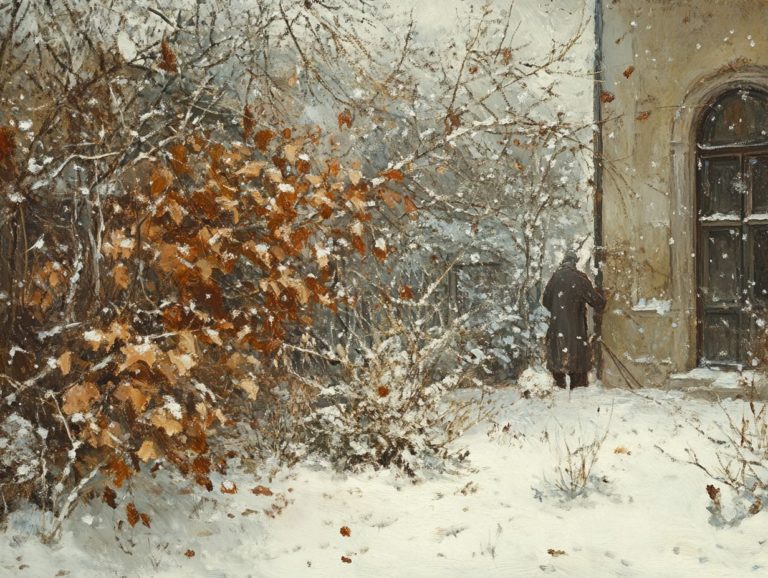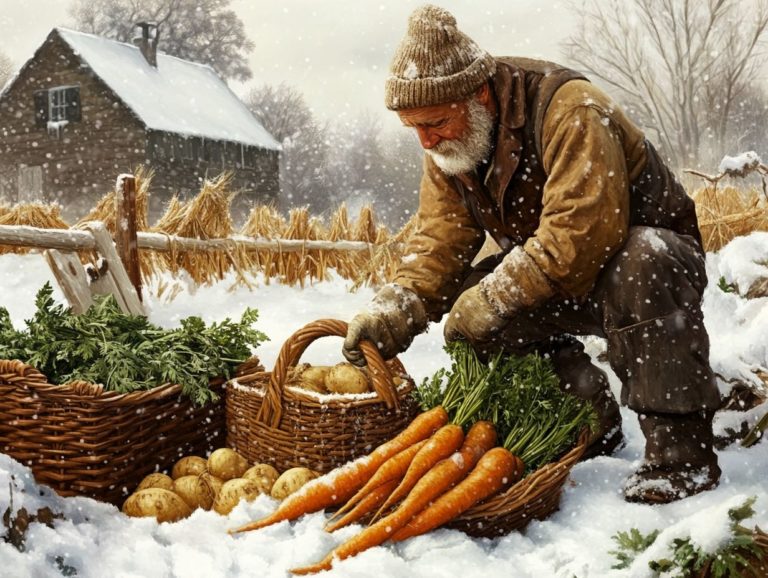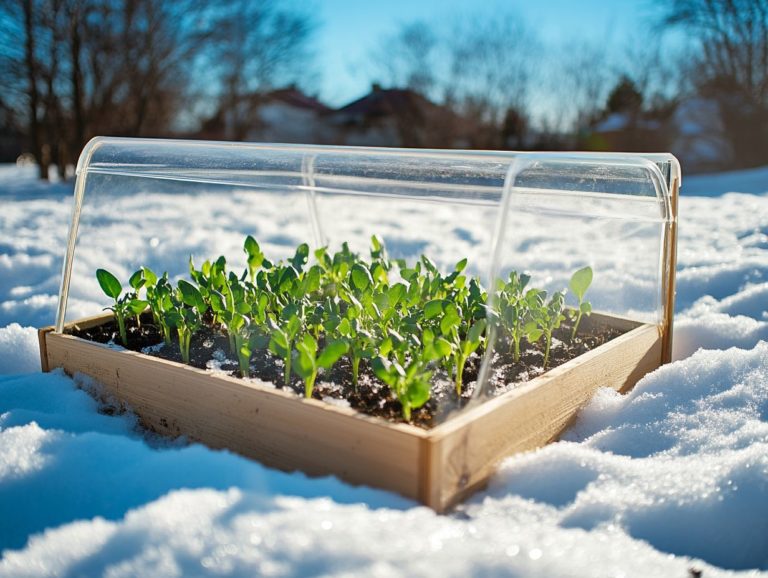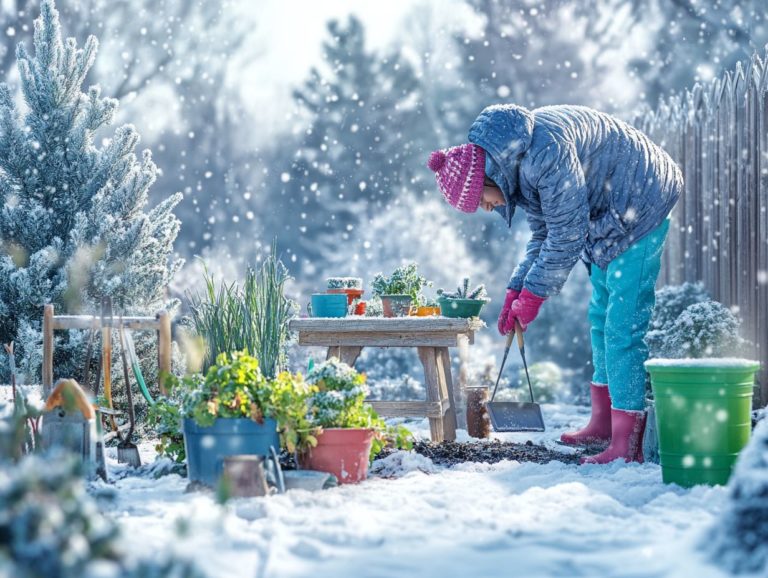Winter Garden Maintenance Checklist
Don t give in to the winter blues your garden needs you! Winter maintenance is key to a flourishing garden come spring. As winter approaches, you might be tempted to stow away your gardening tools and forget about your outdoor spaces until spring. However, neglecting winter garden maintenance can lead to missed opportunities for a vibrant and healthy garden when the warmer months return.
This checklist will guide you through essential tasks such as pruning, protecting plants from frost, and preparing for potential snowfall. By investing a little effort now, you can lay the groundwork for a flourishing garden come spring.
Explore how to properly care for your plants and steer clear of common winter maintenance pitfalls.
Contents
- Key Takeaways:
- 1. Prune Trees and Shrubs
- 2. Clean Up Fallen Leaves and Debris
- 3. Protect Plants from Frost
- 4. Mulch Around Plants
- 5. Check for Pests and Diseases
- 6. Water Plants Appropriately
- 7. Prepare for Snow and Ice
- 8. Cover Sensitive Plants
- 9. Inspect and Repair Garden Structures
- 10. Plan for Spring Planting
- 11. Clean and Store Gardening Tools
- 12. Check and Repair Irrigation Systems
- 13. Fertilize Winter Plants
- 14. Protect Outdoor Furniture and Decorations
- 15. Prepare for Winter Storms
- Why Is Winter Garden Maintenance Important?
- Frequently Asked Questions
- What is a Winter Garden Maintenance Checklist?
- Why is a Winter Garden Maintenance Checklist important?
- What are some tasks that should be included in a Winter Garden Maintenance Checklist?
- When should a Winter Garden Maintenance Checklist be completed?
- Can I create my own Winter Garden Maintenance Checklist?
- What are the benefits of following a Winter Garden Maintenance Checklist?
Key Takeaways:

- Regularly pruning trees and shrubs can promote healthy growth and prevent overgrowth in the winter months.
- Removing fallen leaves and debris can help prevent pest and disease infestations and keep the garden clean and tidy.
- Protecting plants from frost and properly mulching can help them survive the harsh winter weather.
1. Prune Trees and Shrubs
Pruning trees and shrubs during the winter season is an essential gardening task you shouldn t overlook. It s vital for keeping your plants healthy and thriving! This process ensures that optimal sunlight and airflow can reach the core of your plants.
Effective pruning techniques vary significantly depending on the species. For example, deciduous trees thrive with a hard prune to remove any dead or overcrowded branches, promoting robust growth when the warmer months arrive. On the other hand, some shrubs, particularly flowering varieties, require selective pruning after they bloom to ensure a stunning display next year.
Using the right tools is vital sharp shears for delicate branches, loppers for thicker limbs, and saws for larger trunks. This ensures clean cuts and minimizes harm to your plants. Timing is also key; while winter may be ideal for many species, early spring might be better for others just waking from dormancy.
Winter pruning not only aids in disease prevention but also enhances the overall health of your landscape by improving visibility and airflow, reducing moisture, and minimizing the risk of fungal infections.
2. Clean Up Fallen Leaves and Debris
Cleaning up fallen leaves and debris is essential for winter gardening. It helps prevent weed growth, protects your vulnerable plants, and keeps your garden looking its best during the colder months.
Adopting efficient methods for garden cleanup can transform the task from daunting to manageable. Using tools like leaf blowers, rakes, and garden vacuums allows you to gather debris quickly and effectively.
Consider composting the collected leaves and organic matter; not only does this reduce waste, but it also enriches your soil. Composting transforms these materials into nutrient-rich compost, enhancing soil health and structure both vital for sustaining plant growth when spring rolls around.
3. Protect Plants from Frost
To ensure the health of your vulnerable plants, implementing protective measures against frost during the winter season is crucial. Unexpected drops in temperature can inflict serious damage on your garden’s flora.
Using landscape fabric is a highly effective method to create a barrier against cold winds, while covering your plants with frost cloth adds an additional layer of insulation. A generous layer of mulch around the base of your plants not only moderates soil temperature but also retains moisture, which is essential during the colder months.
Proper planning is essential; selecting frost-resistant plant varieties and positioning delicate plants in more sheltered spots can significantly reduce the risk of frost damage. By combining these techniques, you can cultivate an environment that supports your plants even through the harshest winter conditions.
Start your winter prep today for a thriving garden this spring! Share your experiences and tips for winter garden maintenance.
4. Mulch Around Plants
Adding mulch around your plants is a wise winter gardening strategy that protects the roots from freezing temperatures! It also retains soil moisture and suppresses weed growth, ensuring your garden will thrive when spring arrives.
You have several mulch options to choose from. For instance, straw is lightweight and provides excellent insulation, while wood chips decompose slowly, enriching the soil over time.
Aim for a layer about 2 to 4 inches deep. Make sure to keep it away from the plant stems to avoid rot!
Ideally, complete this task before the first hard frost to allow it to settle and connect with the soil.
Beyond enhancing your garden’s visual appeal, mulch significantly improves soil structure and health. It fosters beneficial microorganisms and promotes better water retention.
5. Check for Pests and Diseases
Check regularly for pests and diseases. This is vital for your winter maintenance routine and helps keep your garden safe as spring approaches!
During the colder months, you might encounter pests like aphids and spider mites. Recognizing these unwelcome guests is crucial; look for tiny insects on leaves or fine webbing on stems.
Diseases such as powdery mildew can also linger. These appear as white, powdery spots on your foliage!
To tackle these issues organically, consider introducing beneficial insects like ladybugs or applying neem oil as a natural pesticide.
Implement preventative measures like using row covers and ensuring proper drainage. Keeping your plants healthy with compost can significantly reduce the risk of pest infestations and disease outbreaks.
6. Water Plants Appropriately
Watering your plants properly during winter is essential! Many gardeners underestimate their plants’ water needs as temperatures drop, leading to drying out and poor health.
Regularly assess the soil moisture levels. You can do this by sticking your finger into the soil or using a moisture meter for a precise reading.
Adjust your irrigation system based on these assessments. Winter conditions can vary, impacting your plants’ needs.
Techniques like drip irrigation or soaker hoses are effective during the colder months as they help reduce water evaporation.
Watch for signs of stress or discoloration in your plants. These indicators can provide valuable insights into whether your watering strategy is on point!
7. Prepare for Snow and Ice
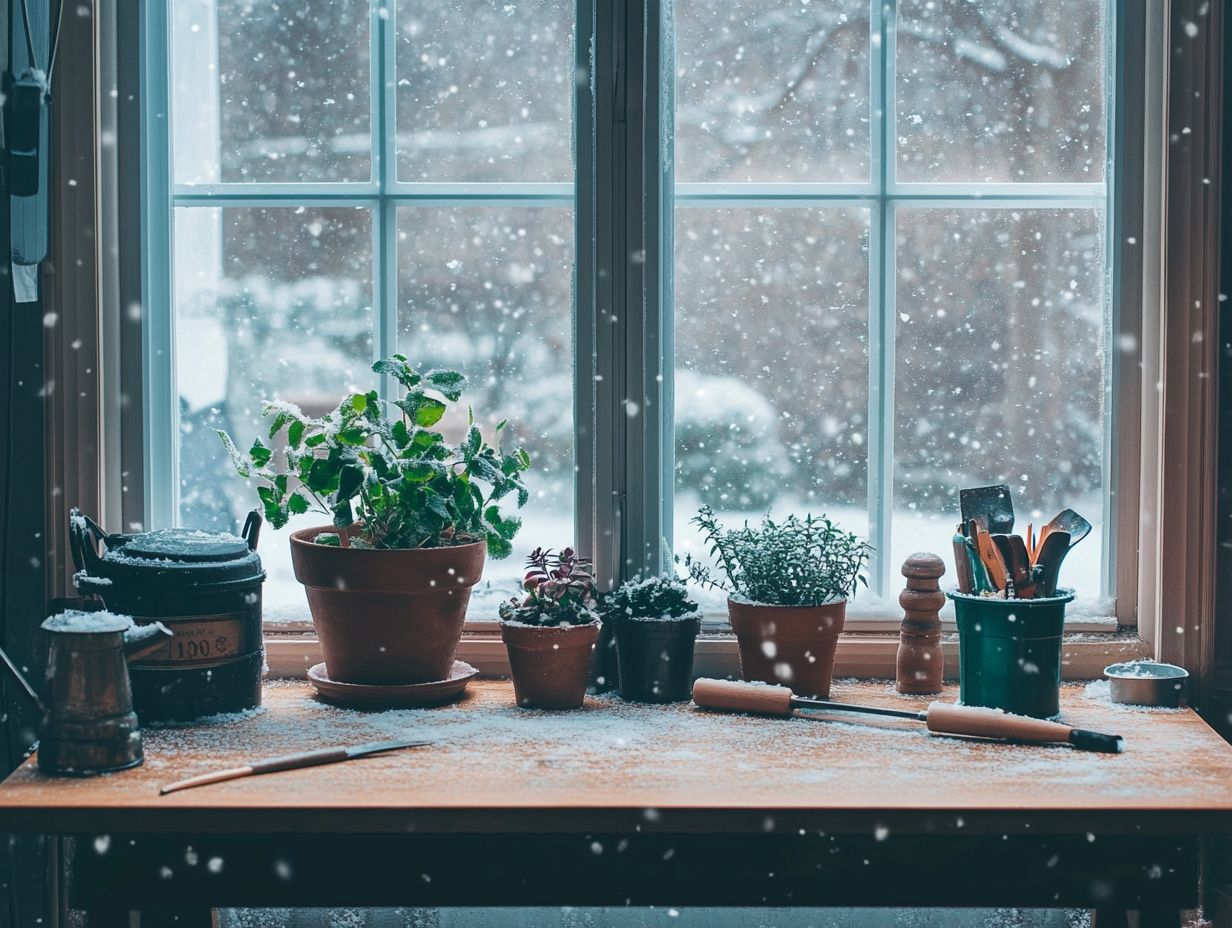
Preparing for snow and ice is crucial for effective winter maintenance. Ensuring your garden is ready to handle heavy snow loads will protect your plants and structures from potential damage!
This preparation involves several proactive strategies that you should consider.
- First, use stakes and supports to help fragile plants withstand the weight of accumulating snow. This prevents breakage and bending.
- Understanding the importance of timely snow removal can make a world of difference! Gently clearing snow from delicate branches and structures alleviates stress on your plants.
- Also, prepare your outdoor furniture and decorations. Ensure they are either stored away or properly protected so that you can safely enjoy them when spring arrives.
8. Cover Sensitive Plants
Covering sensitive plants is an essential winter gardening task. It protects them from harsh elements and frost, ensuring their survival through the colder months. This also promotes their rejuvenation as the season shifts.
Use materials like cloches, garden blankets, and burlap to protect delicate foliage. Cloches create a small greenhouse around each plant, trapping warmth and moisture. Meanwhile, garden blankets are perfect for draping entire flower beds, allowing air to flow while keeping frost away. Burlap is another versatile option; it delivers insulation while allowing airflow, crucial for mold prevention.
As spring approaches, keep a close eye on temperatures and the unique needs of each plant. Generally, you can safely uncover them when nighttime temperatures consistently remain above freezing, signaling a welcoming return to outdoor conditions.
9. Inspect and Repair Garden Structures
Inspecting and repairing your garden structures during the winter months is essential. Extreme weather can wreak havoc, jeopardizing the integrity of features like fences, trellises, and raised beds.
Before the chill truly settles in, take a leisurely stroll through your garden, checking each element for signs of damage or wear.
Here are some critical tools for your repairs:
- A sturdy hammer
- Wood screws
- Weather-resistant paint or sealant to guard against moisture
Utilizing a level will ensure everything stays structurally sound. Keeping up with seasonal maintenance allows these structures to withstand snow and ice while fostering a healthier garden environment.
This is also an opportune moment to tidy up your garden tools post-growing season. Make sure they re clean and properly stored, ready for action come spring!
10. Plan for Spring Planting
Planning for spring planting during the winter season presents a golden opportunity. Think carefully about which seeds to sow, when to start them indoors, and how to prepare your garden beds for an abundant harvest.
Understanding the unique characteristics of your local climate and soil conditions is vital for selecting seeds that will thrive. For instance, if you reside in cooler regions, cool-season varieties are more suitable, while those in warmer areas can benefit from heat-tolerant options.
Timing plays a crucial role. Start seeds indoors about 6-8 weeks before the last frost to help your young plants acclimate seamlessly. Prepare your garden beds with rich compost to enhance soil structure and boost fertility. Applying mulch helps conserve moisture and keeps pesky weeds at bay.
Consider companion planting to use your garden space effectively and keep pests away, fostering a more harmonious garden ecosystem.
11. Clean and Store Gardening Tools
Cleaning and storing your gardening tools during the winter season is essential. Proper maintenance ensures their longevity and effectiveness for the upcoming growing season.
Cleaning your tools isn’t just a routine chore; it’s an investment in the future of your gardening endeavors. Start by scrubbing off any dirt, grime, or plant residue with a wire brush or a putty knife, paying close attention to those tricky crevices where soil tends to hide.
Once your tools are clean, drying each one is vital to prevent moisture buildup that leads to rust. After they re dry, apply a thin layer of oil to the metal parts. This protects them from corrosion and enhances their performance with every use.
Proper storage is key. Hanging your tools in a dry location instead of leaving them in a damp shed can significantly extend their lifespan. Opting for eco-friendly cleaning products supports sustainable gardening practices while safeguarding your health and the environment.
Don t wait! Clean your tools now, and they ll reward you with great performance in spring.
12. Check and Repair Irrigation Systems
Checking and repairing your irrigation systems during winter maintenance is essential. This preparation ensures your watering setup is fully functional.
Make sure it’s ready for the upcoming planting season.
During this time, it s vital to conduct a thorough assessment for any leaks that could waste water and compromise the efficiency of your system. Begin by visually inspecting all hoses, pipes, and fittings for signs of damage or corrosion. If you spot any issues, it’s best to address them promptly.
To prevent freezing and subsequent damage, implement proper winterization techniques, such as draining water from the pipes and insulating exposed areas.
Regular maintenance, including these checks, is crucial. Not only does it optimize performance when spring arrives, but it also extends the lifespan of your irrigation components, ensuring they remain reliable for all your future gardening needs.
13. Fertilize Winter Plants
Fertilizing winter plants is an essential part of winter gardening, providing the vital nutrients necessary to enhance their growth during those dormant periods and to prepare them for a spectacular spring bloom.
Selecting the right type of fertilizer is key. Options like slow-release granules (which release nutrients gradually) or organic fertilizers deliver a balanced supply of nutrients while reducing the risk of burning those delicate roots.
When you re ready to apply these fertilizers, aim for a dry day. This ensures even distribution and allows the nutrients to penetrate the soil effectively.
Incorporating compost into your soil can significantly improve its structure and nutrient content, serving as a natural amendment that enriches soil health throughout the winter months.
Compost not only nourishes your plants but also supports beneficial microorganisms, setting the stage for vibrant growth come spring.
14. Protect Outdoor Furniture and Decorations
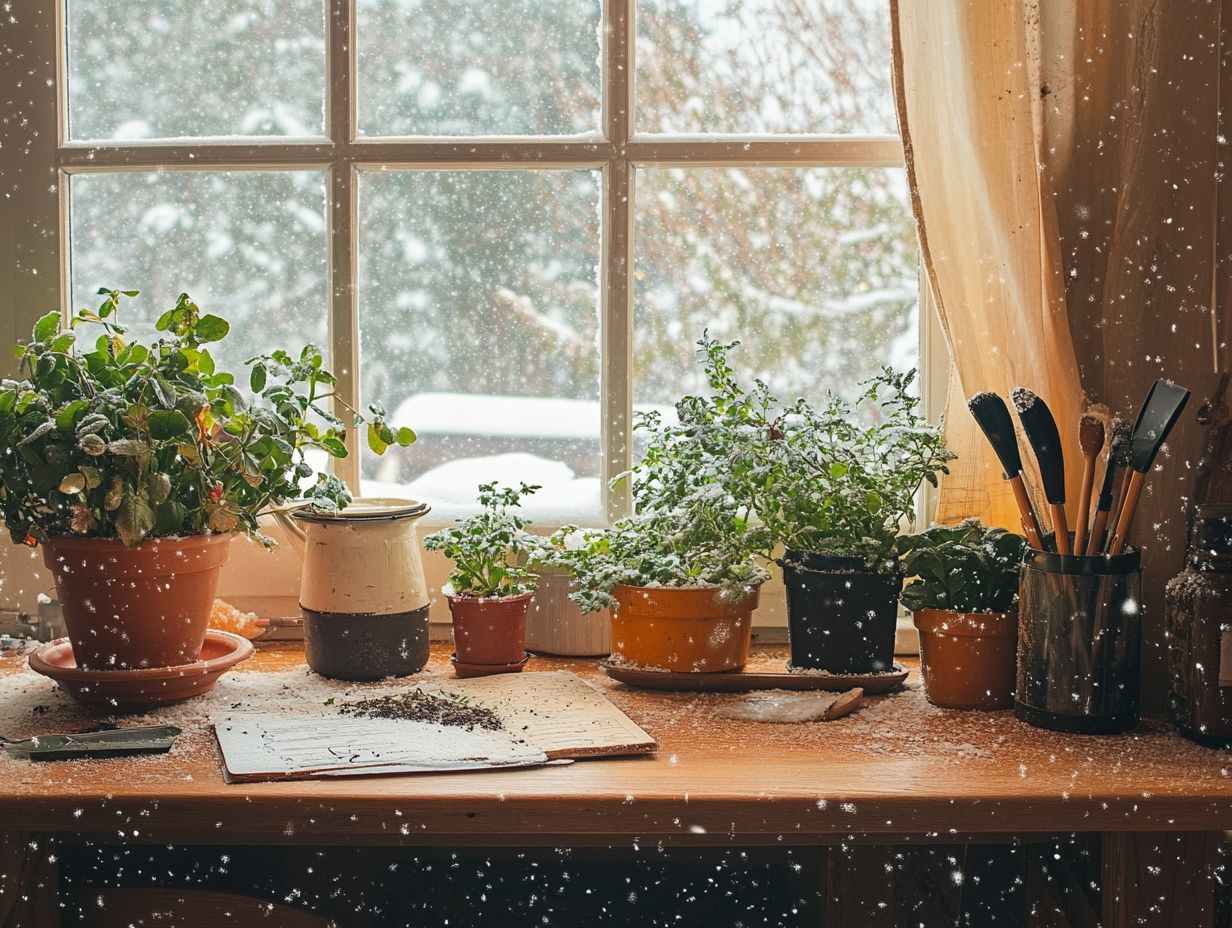
Protecting your outdoor furniture and decorations is essential for winter maintenance. With the right care, you can significantly extend their lifespan and keep them looking great despite harsh weather conditions.
To achieve this, consider employing several effective strategies:
- Cover your furniture with breathable, waterproof tarps to prevent moisture buildup and protect against dirt and debris. This way, your pieces will be in excellent shape when spring arrives.
- Apply protective sprays specifically designed for outdoor materials to shield surfaces from corrosive elements like snow and ice.
- Make it a habit to inspect and maintain your outdoor decorations regularly. Proper cleaning and storage will go a long way in preventing damage.
By taking this proactive approach, you ll ensure that your outdoor items remain in pristine condition and are ready to shine when the warmer days return.
15. Prepare for Winter Storms
Preparing for winter storms is essential to safeguarding your garden. By understanding how to protect your plants, structures, and tools, you can prevent significant damage from heavy winds and snowfall.
Employ specific strategies, such as staking vulnerable plants and reinforcing structures, to significantly reduce the risk of uprooting and breakage. Remove lightweight items like garden decorations or furniture from outdoor spaces to prevent them from becoming dangerous projectiles in harsh winds.
Keep an eye on weather forecasts! Timely preparations can save your garden from storms. Monitoring upcoming weather allows you to act proactively, ensuring that your cherished plants and structures are well-protected against the elements.
Why Is Winter Garden Maintenance Important?
Winter garden maintenance is essential for you, not just to shield your plants from the biting cold, but also to prepare your entire garden ecosystem for a flourishing growing season. This is your opportunity to engage in proactive care using important gardening tools and methods.
By dedicating time and effort during the dormant season, you can greatly enhance plant health. This ensures that roots are robust and primed to thrive when spring arrives. This season is particularly advantageous for improving soil structure.
Activities like mulching spreading a layer of material on the soil to protect plants and composting can stimulate microbial activity and boost nutrient availability.
Tackling potential pest issues before they spiral out of control can lead to reduced populations by the time spring rolls around. This allows you to minimize reliance on chemical treatments. Therefore, with thoughtful planning and execution of winter maintenance, you not only protect your existing plants but also lay the groundwork for a lush, vibrant garden to greet the warmer days ahead.
What Are the Key Tasks to Include in a Winter Garden Maintenance Checklist?
A winter garden maintenance checklist is essential for you to ensure that all critical gardening tasks are completed, safeguarding your plants and getting your garden ready for the upcoming challenges of spring.
With the right approach, winter gardening can transform into an invaluable routine that sets the foundation for a thriving garden. Key tasks, such as timely pruning, should not be overlooked. Removing dead or damaged branches now ensures healthier growth when spring arrives.
Cleaning your garden area not only banishes pests but also prepares the soil for new planting opportunities. Applying mulch acts as an insulator for roots while keeping those pesky weeds at bay.
Don t forget to inspect your garden structures, like fences and trellises, to identify and address any damage before the growing season begins. Utilizing the right tools be it sharp shears or a sturdy rake will enhance the effectiveness of your efforts, contributing to a vibrant and flourishing garden environment.
How Can a Garden Benefit from Winter Maintenance?
A garden can reap substantial benefits from winter maintenance, promoting healthy plants, keeping pests away, and enhancing soil quality each factor contributing to a vibrant landscape come spring.
By dedicating time to essential tasks like mulching and pruning during the colder months, you cultivate resilience in your plants. This prepares them to endure the harshness of winter. For instance, properly mulched flower beds act as a shield, preventing frost from reaching the roots, resulting in earlier blooms and more robust growth as temperatures rise.
When you prioritize winter maintenance, you ll notice a significant reduction in pest populations in the following seasons. This minimizes the need for extensive interventions later in the year. This smart strategy not only saves you time but makes your garden thrive!
What Are the Common Mistakes to Avoid in Winter Garden Maintenance?
Avoiding common mistakes in winter garden maintenance is crucial for safeguarding your plants and ensuring a smooth transition into the vibrant spring growing season.
One of the most frequent oversights you might encounter is neglecting to prune, which can lead to overcrowded branches and stunted growth. Overwatering during the colder months is another trap; it can result in root rot and weaken your plants. Failing to provide adequate frost protection can harm delicate varieties.
To maintain optimal plant health, consider implementing a routine check-up on your garden s moisture levels and adjust as needed. Using mulch for insulation and timing your pruning to promote airflow and strength are essential steps.
With careful attention to these details, you can ensure your plants thrive, even in the harshest winter conditions.
How Can a Garden Be Prepared for Spring during Winter Maintenance?
Prepare your garden for spring during winter. This involves strategic planning and thoughtful actions that set the stage for vibrant growth when the weather warms up.
This preparation boosts your chances of a lush, colorful landscape in spring. Explore late-season planting options, like choosing cold-tolerant varieties that can withstand chilly temperatures.
Enhance soil quality by adding organic matter, like compost. Outline your vision for spring flowers and choose compatible plants that will thrive together for optimal beauty and health.
Early preparation nurtures a thriving garden. It also makes the spring planting process smoother and more enjoyable.
Frequently Asked Questions
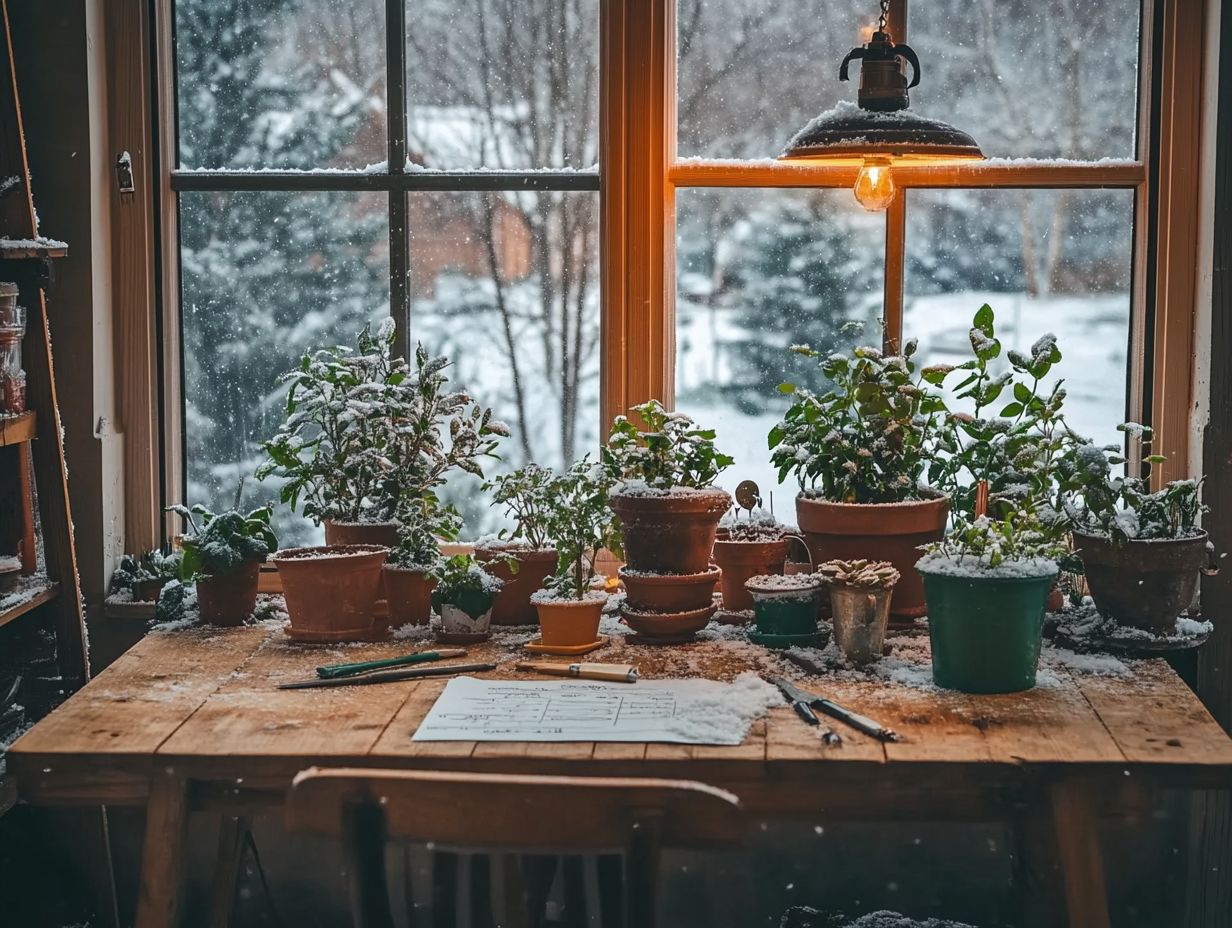
What is a Winter Garden Maintenance Checklist?
A Winter Garden Maintenance Checklist is a list of tasks that gardeners should complete before and during the winter season to prepare their gardens for colder weather and ensure the health and longevity of their plants.
Why is a Winter Garden Maintenance Checklist important?
A Winter Garden Maintenance Checklist helps prepare your garden for colder weather, ensuring your plants survive and thrive come spring. It also helps prevent common winter garden problems such as frozen pipes, pest infestations, and plant damage.
What are some tasks that should be included in a Winter Garden Maintenance Checklist?
Some tasks to include are cleaning up fallen leaves and debris, protecting plants from frost, pruning and trimming, fertilizing, and preparing garden beds for spring planting.
When should a Winter Garden Maintenance Checklist be completed?
A Winter Garden Maintenance Checklist should be completed before the first frost of the season, usually in late fall. Some tasks, such as protecting plants from frost, may need to be done throughout the winter as needed.
Can I create my own Winter Garden Maintenance Checklist?
Yes, you can create your own Winter Garden Maintenance Checklist based on your garden’s specific needs. However, it is also recommended to seek guidance from experienced gardeners or consult with a local gardening center for additional tips and advice.
What are the benefits of following a Winter Garden Maintenance Checklist?
Following a Winter Garden Maintenance Checklist helps ensure that your garden remains healthy and thriving throughout winter. Additionally, using winter gardening tool maintenance tips saves time and effort in the spring, as the garden will already be prepared for new growth and planting.



